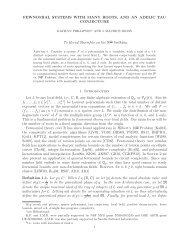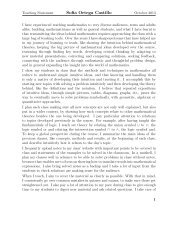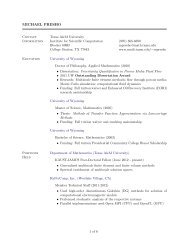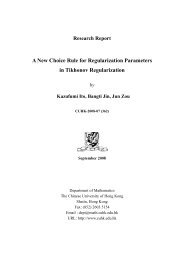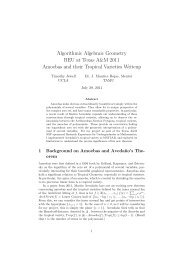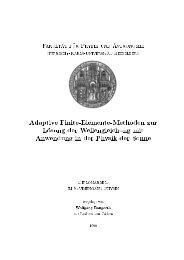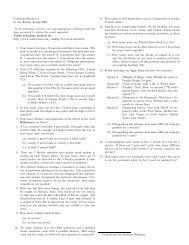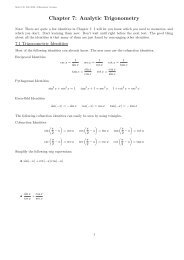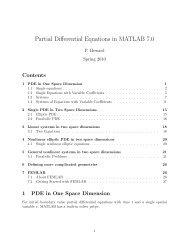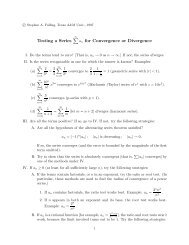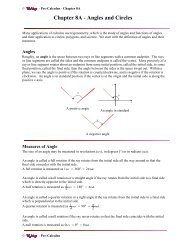Pythagoras and the Pythagoreans - Department of Mathematics
Pythagoras and the Pythagoreans - Department of Mathematics
Pythagoras and the Pythagoreans - Department of Mathematics
Create successful ePaper yourself
Turn your PDF publications into a flip-book with our unique Google optimized e-Paper software.
<strong>Pythagoras</strong> <strong>and</strong> <strong>the</strong> <strong>Pythagoreans</strong> 1<br />
Historically, <strong>the</strong> name <strong>Pythagoras</strong> meansmuchmorethan<strong>the</strong><br />
familiar namesake <strong>of</strong> <strong>the</strong> famous <strong>the</strong>orem about right triangles. The<br />
philosophy <strong>of</strong> <strong>Pythagoras</strong> <strong>and</strong> his school has become a part <strong>of</strong> <strong>the</strong> very<br />
fiber <strong>of</strong> ma<strong>the</strong>matics, physics, <strong>and</strong> even <strong>the</strong> western tradition <strong>of</strong> liberal<br />
education, no matter what <strong>the</strong> discipline.<br />
The stamp above depicts a coin issued by Greece on August 20,<br />
1955, to commemorate <strong>the</strong> 2500th anniversary <strong>of</strong> <strong>the</strong> founding <strong>of</strong> <strong>the</strong><br />
first school <strong>of</strong> philosophy by <strong>Pythagoras</strong>. Pythagorean philosophy was<br />
<strong>the</strong> prime source <strong>of</strong> inspiration for Plato <strong>and</strong> Aristotle whose influence<br />
on western thought is without question <strong>and</strong> is immeasurable.<br />
1 c°G. Donald Allen, 1999
<strong>Pythagoras</strong> <strong>and</strong> <strong>the</strong> <strong>Pythagoreans</strong> 2<br />
1 <strong>Pythagoras</strong> <strong>and</strong> <strong>the</strong> <strong>Pythagoreans</strong><br />
Of his life, little is known. <strong>Pythagoras</strong> (fl 580-500, BC) was born in<br />
Samos on <strong>the</strong> western coast <strong>of</strong> what is now Turkey. He was reportedly<br />
<strong>the</strong> son <strong>of</strong> a substantial citizen, Mnesarchos. He met Thales, likely as a<br />
young man, who recommended he travel to Egypt. It seems certain that<br />
he gained much <strong>of</strong> his knowledge from <strong>the</strong> Egyptians, as had Thales<br />
before him. He had a reputation <strong>of</strong> having a wide range <strong>of</strong> knowledge<br />
over many subjects, though to one author as having little wisdom (Heraclitus)<br />
<strong>and</strong> to ano<strong>the</strong>r as pr<strong>of</strong>oundly wise (Empedocles). Like Thales,<br />
<strong>the</strong>re are no extant written works by <strong>Pythagoras</strong> or <strong>the</strong> <strong>Pythagoreans</strong>.<br />
Our knowledge about <strong>the</strong> <strong>Pythagoreans</strong> comes from o<strong>the</strong>rs, including<br />
Aristotle, Theon <strong>of</strong> Smyrna, Plato, Herodotus, Philolaus <strong>of</strong> Tarentum,<br />
<strong>and</strong> o<strong>the</strong>rs.<br />
Samos<br />
Miletus<br />
Cnidus<br />
<strong>Pythagoras</strong> lived on Samos for many years under <strong>the</strong> rule <strong>of</strong><br />
<strong>the</strong> tyrant Polycrates, who had a tendency to switch alliances in times<br />
<strong>of</strong> conflict — which were frequent. Probably because <strong>of</strong> continual<br />
conflicts <strong>and</strong> strife in Samos, he settled in Croton, on <strong>the</strong> eastern coast<br />
<strong>of</strong> Italy, a place <strong>of</strong> relative peace <strong>and</strong> safety. Even so, just as he arrived
<strong>Pythagoras</strong> <strong>and</strong> <strong>the</strong> <strong>Pythagoreans</strong> 3<br />
in about 532 BCE, Croton lost a war to neighboring city Locri, but<br />
soon <strong>the</strong>reafter defeated utterly <strong>the</strong> luxurious city <strong>of</strong> Sybaris. This is<br />
where <strong>Pythagoras</strong> began his society.<br />
2 The Pythagorean School<br />
The school <strong>of</strong> <strong>Pythagoras</strong> was every bit as much a religion as a school<br />
<strong>of</strong> ma<strong>the</strong>matics. A rule <strong>of</strong> secrecy bound <strong>the</strong> members to <strong>the</strong> school,<br />
<strong>and</strong> oral communication was <strong>the</strong> rule. The <strong>Pythagoreans</strong> had numerous<br />
rules for everyday living. For example, here are a few <strong>of</strong> <strong>the</strong>m:<br />
.<br />
• To abstain from beans.<br />
• Nottopickupwhathasfallen.<br />
• Not to touch a white cock.<br />
• Not to stir <strong>the</strong> fire with iron.<br />
• Do not look in a mirror beside a light.<br />
Vegetarianism was strictly practiced probably because <strong>Pythagoras</strong><br />
preached <strong>the</strong> transmigration <strong>of</strong> souls 2 .<br />
What is remarkable is that despite <strong>the</strong> lasting contributions <strong>of</strong> <strong>the</strong><br />
<strong>Pythagoreans</strong> to philosophy <strong>and</strong> ma<strong>the</strong>matics, <strong>the</strong> school <strong>of</strong> <strong>Pythagoras</strong><br />
represents <strong>the</strong> mystic tradition in contrast with <strong>the</strong> scientific. Indeed,<br />
<strong>Pythagoras</strong> regarded himself as a mystic <strong>and</strong> even semi-divine. Said<br />
<strong>Pythagoras</strong>,<br />
“There are men, gods, <strong>and</strong> men like <strong>Pythagoras</strong>.”<br />
It is likely that <strong>Pythagoras</strong> was a charismatic, as well.<br />
Life in <strong>the</strong> Pythagorean society was more-or-less egalitarian.<br />
• The Pythagorean school regarded men <strong>and</strong> women equally.<br />
2 reincarnation
<strong>Pythagoras</strong> <strong>and</strong> <strong>the</strong> <strong>Pythagoreans</strong> 4<br />
• They enjoyed a common way <strong>of</strong> life.<br />
• Property was communal.<br />
• Even ma<strong>the</strong>matical discoveries were communal <strong>and</strong> by association<br />
attributed to <strong>Pythagoras</strong> himself — even from <strong>the</strong> grave. Hence,<br />
exactly what <strong>Pythagoras</strong> personally discovered is difficult to ascertain.<br />
Even Aristotle <strong>and</strong> those <strong>of</strong> his time were unable to attribute<br />
direct contributions from <strong>Pythagoras</strong>, always referring to<br />
‘<strong>the</strong> <strong>Pythagoreans</strong>’, or even <strong>the</strong> ‘so-called <strong>Pythagoreans</strong>’. Aristotle,<br />
in fact, wrote <strong>the</strong> book On <strong>the</strong> <strong>Pythagoreans</strong> which is now<br />
lost.<br />
The Pythagorean Philosophy<br />
The basis <strong>of</strong> <strong>the</strong> Pythagorean philosophy is simply stated:<br />
“There are three kinds <strong>of</strong> men <strong>and</strong> three sorts <strong>of</strong> people<br />
that attend <strong>the</strong> Olympic Games. The lowest class is made<br />
up <strong>of</strong> those who come to buy <strong>and</strong> sell, <strong>the</strong> next above <strong>the</strong>m<br />
are those who compete. Best <strong>of</strong> all, however, are those who<br />
come simply to look on. The greatest purification <strong>of</strong> all is,<br />
<strong>the</strong>refore, disinterested science, <strong>and</strong> it is <strong>the</strong> man who devotes<br />
himself to that, <strong>the</strong> true philosopher, who has most effectually<br />
released himself from <strong>the</strong> ‘wheel <strong>of</strong> birth’.” 3<br />
The message <strong>of</strong> this passage is radically in conflict with modern values.<br />
We need only consider sports <strong>and</strong> politics.<br />
? Is not reverence <strong>the</strong>se days is bestowed only on <strong>the</strong> “superstars”?<br />
? Are not <strong>the</strong>re ubiquitous dem<strong>and</strong>s for accountability.<br />
The gentleman 4 , <strong>of</strong> this passage, has had a long run with this<br />
philosophy, because he was associated with <strong>the</strong> Greek genius, because<br />
3 Burnet, Early Greek Philosophy<br />
4 How many such philosophers are icons <strong>of</strong> <strong>the</strong> western tradition? We can include Hume,<br />
Locke, Descartes, Fermat, Milton, Gö<strong>the</strong>, Thoreau. Compare <strong>the</strong>se names to Napoleon, Nelson,<br />
Bismark, Edison, Whitney, James Watt. You get a different feel.
<strong>Pythagoras</strong> <strong>and</strong> <strong>the</strong> <strong>Pythagoreans</strong> 5<br />
<strong>the</strong> “virtue <strong>of</strong> contemplation” acquired <strong>the</strong>ological endorsement, <strong>and</strong><br />
because <strong>the</strong> ideal <strong>of</strong> disinterested truth dignified <strong>the</strong> academic life.<br />
The Pythagorean Philosophy ála Bertr<strong>and</strong> Russell<br />
From Bertr<strong>and</strong> Russell, 5 ,wehave<br />
“It is to this gentleman that we owe pure ma<strong>the</strong>matics.<br />
The contemplative ideal — since it led to pure ma<strong>the</strong>matics<br />
— was <strong>the</strong> source <strong>of</strong> a useful activity. This increased it’s<br />
prestige <strong>and</strong> gave it a success in <strong>the</strong>ology, in ethics, <strong>and</strong> in<br />
philosophy.”<br />
Ma<strong>the</strong>matics, so honored, became <strong>the</strong> model for o<strong>the</strong>r sciences.<br />
Thought became superior to <strong>the</strong> senses; intuition became superior to<br />
observation. The combination <strong>of</strong> ma<strong>the</strong>matics <strong>and</strong> <strong>the</strong>ology began with<br />
<strong>Pythagoras</strong>. It characterized <strong>the</strong> religious philosophy in Greece, in <strong>the</strong><br />
Middle ages, <strong>and</strong> down through Kant. In Plato, Aquinas, Descartes,<br />
Spinoza <strong>and</strong> Kant <strong>the</strong>re is a blending <strong>of</strong> religion <strong>and</strong> reason, <strong>of</strong> moral<br />
aspiration with logical admiration <strong>of</strong> what is timeless.<br />
Platonism was essentially Pythagoreanism. The whole concept<br />
<strong>of</strong> an eternal world revealed to intellect but not to <strong>the</strong> senses can be<br />
attributed from <strong>the</strong> teachings <strong>of</strong> <strong>Pythagoras</strong>.<br />
The Pythagorean School gained considerable influence in Croton<br />
<strong>and</strong> became politically active — on <strong>the</strong> side <strong>of</strong> <strong>the</strong> aristocracy. Probably<br />
because <strong>of</strong> this, after a time <strong>the</strong> citizens turned against him <strong>and</strong> his<br />
followers, burning his house. Forced out, he moved to Metapontum,<br />
also in Sou<strong>the</strong>rn Italy. Here he died at <strong>the</strong> age <strong>of</strong> eighty. His school lived<br />
on, alternating between decline <strong>and</strong> re-emergence, for several hundred<br />
years. Tradition holds that <strong>Pythagoras</strong> left no written works, but that<br />
hisideaswerecarriedonbyeagerdisciples.<br />
5 A History <strong>of</strong> Western Philosophy. Russell was a logician, ma<strong>the</strong>matician <strong>and</strong> philosopher from<br />
<strong>the</strong> Þrst half <strong>of</strong> <strong>the</strong> twentieth century. He is known for attempting to bring pure ma<strong>the</strong>matics<br />
into <strong>the</strong> scope <strong>of</strong> symbolic logic <strong>and</strong> for discovering some pr<strong>of</strong>ound paradoxes in set <strong>the</strong>ory.
<strong>Pythagoras</strong> <strong>and</strong> <strong>the</strong> <strong>Pythagoreans</strong> 6<br />
3 Pythagorean Ma<strong>the</strong>matics<br />
What is known <strong>of</strong> <strong>the</strong> Pythagorean school is substantially from a book<br />
written by <strong>the</strong> Pythagorean, Philolaus (fl. c. 475BCE)<strong>of</strong>Tarentum.<br />
However, according to <strong>the</strong> 3rd-century-AD Greek historian Diogenes<br />
Laërtius, he was born at Croton. After <strong>the</strong> death <strong>of</strong> <strong>Pythagoras</strong>, dissension<br />
was prevalent in Italian cities, Philolaus may have fled first to<br />
Lucania <strong>and</strong> <strong>the</strong>n to Thebes, in Greece. Later, upon returning to Italy,<br />
he may have been a teacher <strong>of</strong> <strong>the</strong> Greek thinker Archytas. From his<br />
book Plato learned <strong>the</strong> philosophy <strong>of</strong> <strong>Pythagoras</strong>.<br />
The dictum <strong>of</strong> <strong>the</strong> Pythagorean school was<br />
All is number<br />
The origin <strong>of</strong> this model may have been in <strong>the</strong> study <strong>of</strong> <strong>the</strong> constellations,<br />
where each constellation possessed a certain number <strong>of</strong> stars <strong>and</strong><br />
<strong>the</strong> geometrical figure which it forms. What this dictum meant was<br />
that all things <strong>of</strong> <strong>the</strong> universe had a numerical attribute that uniquely<br />
described <strong>the</strong>m. Even stronger, it means that all things which can be<br />
known or even conceived have number. Stronger still, not only do<br />
all things possess numbers, but all things are numbers. As Aristotle<br />
observes, <strong>the</strong> <strong>Pythagoreans</strong> regarded that number is both <strong>the</strong> principle<br />
matter for things <strong>and</strong> for constituting <strong>the</strong>ir attributes <strong>and</strong> permanent<br />
states. There are <strong>of</strong> course logical problems, here. (Using a basis to describe<br />
<strong>the</strong> same basis is usually a risky venture.) That <strong>Pythagoras</strong> could<br />
accomplish this came in part from fur<strong>the</strong>r discoveries such musical harmonics<br />
<strong>and</strong> knowledge about what are now called Pythagorean triples.<br />
This is somewhat different from <strong>the</strong> Ionian school, where <strong>the</strong> elemental<br />
force <strong>of</strong> nature was some physical quantity such as water or air. Here,<br />
we see a model <strong>of</strong> <strong>the</strong> universe with number as its base, a ra<strong>the</strong>r abstract<br />
philosophy.<br />
Even qualities, states, <strong>and</strong> o<strong>the</strong>r aspects <strong>of</strong> nature had descriptive<br />
numbers. For example,<br />
• The number one : <strong>the</strong> number <strong>of</strong> reason.<br />
• The number two: <strong>the</strong> first even or female number, <strong>the</strong> number <strong>of</strong><br />
opinion.<br />
• The number three: <strong>the</strong> first true male number, <strong>the</strong> number <strong>of</strong><br />
harmony.
<strong>Pythagoras</strong> <strong>and</strong> <strong>the</strong> <strong>Pythagoreans</strong> 7<br />
• The number four: <strong>the</strong> number <strong>of</strong> justice or retribution.<br />
• The number five: marriage.<br />
• The number six: creation<br />
.<br />
• The number ten: <strong>the</strong>tetractys, <strong>the</strong> number <strong>of</strong> <strong>the</strong> universe.<br />
The <strong>Pythagoreans</strong> expended great effort to form <strong>the</strong> numbers from<br />
a single number, <strong>the</strong> Unit, (i.e. one). They treated <strong>the</strong> unit, which is a<br />
point without position, as a point, <strong>and</strong> a point as a unit having position.<br />
The unit was not originally considered a number, because a measure is<br />
not <strong>the</strong> things measured, but <strong>the</strong> measure <strong>of</strong> <strong>the</strong> One is <strong>the</strong> beginning<br />
<strong>of</strong> number. 6 This view is reflected in Euclid 7 whereherefersto<strong>the</strong><br />
multitude as being comprised <strong>of</strong> units, <strong>and</strong> a unit is that by virtue <strong>of</strong><br />
which each <strong>of</strong> existing things is called one. The first definition <strong>of</strong><br />
number is attributed to Thales, who defined it as a collection <strong>of</strong> units,<br />
clearly a derivate based on Egyptians arithmetic which was essentially<br />
grouping. Numerous attempts were made throughout Greek history to<br />
determine <strong>the</strong> root <strong>of</strong> numbers possessing some consistent <strong>and</strong> satisfying<br />
philosophical basis. This argument could certainly qualify as one <strong>of</strong> <strong>the</strong><br />
earliest forms <strong>of</strong> <strong>the</strong> philosophy <strong>of</strong> ma<strong>the</strong>matics.<br />
The greatest <strong>of</strong> <strong>the</strong> numbers, ten, was so named for several reasons.<br />
Certainly, it is <strong>the</strong> base <strong>of</strong> Egyptian <strong>and</strong> Greek counting. It also<br />
contains <strong>the</strong> ratios <strong>of</strong> musical harmonies: 2:1 for <strong>the</strong> octave, 3:2 for <strong>the</strong><br />
fifth, <strong>and</strong> 4:3 for <strong>the</strong> fourth. We may also note <strong>the</strong> only regular figures<br />
known at that time were <strong>the</strong> equilateral triangle, square, <strong>and</strong> pentagon 8<br />
were also contained by within tetractys. Speusippus (d. 339 BCE)<br />
notes <strong>the</strong> geometrical connection.<br />
Dimension:<br />
One point: generator <strong>of</strong> dimensions (point).<br />
Two points: generator <strong>of</strong> a line <strong>of</strong> dimension one<br />
6 Aristotle, Metaphysics<br />
7 The Elements<br />
8 O<strong>the</strong>rs such as <strong>the</strong> hexagon, octagon, etc. are easily constructed regular polygons with<br />
number <strong>of</strong> sides as multiples <strong>of</strong> <strong>the</strong>se. The 15-gon, which is a multiple <strong>of</strong> three <strong>and</strong> Þve sides<br />
is also constructible. These polygons <strong>and</strong> <strong>the</strong>ir side multiples by powers <strong>of</strong> two were all those<br />
known.
<strong>Pythagoras</strong> <strong>and</strong> <strong>the</strong> <strong>Pythagoreans</strong> 8<br />
Three points: generator <strong>of</strong> a triangle <strong>of</strong> dimension two<br />
Four points: generator <strong>of</strong> a tetrahedron, <strong>of</strong> dimension three.<br />
The sum <strong>of</strong> <strong>the</strong>se is ten <strong>and</strong> represents all dimensions. Note <strong>the</strong> abstraction<br />
<strong>of</strong> concept. This is quite an intellectual distance from “fingers<br />
<strong>and</strong> toes”.<br />
Classification <strong>of</strong> numbers. The distinction between even <strong>and</strong> odd<br />
numbers certainly dates to <strong>Pythagoras</strong>. From Philolaus, we learn that<br />
“...number is <strong>of</strong> two special kinds, odd <strong>and</strong> even, with a<br />
third, even-odd, arising from a mixture <strong>of</strong> <strong>the</strong> two; <strong>and</strong> <strong>of</strong><br />
each kind <strong>the</strong>re are many forms.”<br />
And <strong>the</strong>se, even <strong>and</strong> odd, correspond to <strong>the</strong> usual definitions, though<br />
expressed in unusual way 9 .Buteven-odd means a product <strong>of</strong> two <strong>and</strong><br />
odd number, though later it is an even time an odd number. O<strong>the</strong>r<br />
subdivisions <strong>of</strong> even numbers 10 are reported by Nicomachus (a neo-<br />
Pythagorean∼100 A.D.).<br />
• even-even — 2 n<br />
• even-odd — 2(2m +1)<br />
• odd-even — 2 n+1 (2m +1)<br />
Originally (our) number 2, <strong>the</strong> dyad, was not considered even,<br />
though Aristotle refers to it as <strong>the</strong> only even prime. This particular<br />
direction <strong>of</strong> ma<strong>the</strong>matics, though it is based upon <strong>the</strong> earliest ideas<br />
<strong>of</strong> factoring, was eventually ab<strong>and</strong>oned as not useful, though even <strong>and</strong><br />
odd numbers <strong>and</strong> especially prime numbers play a major role in modern<br />
number <strong>the</strong>ory.<br />
Prime or incomposite numbers <strong>and</strong> secondary or composite numbers<br />
are defined in Philolaus:<br />
9 Nicomachus <strong>of</strong> Gerase (ß 100CE)givesasancient<strong>the</strong>deÞnition that an even number is<br />
that which can be divided in to two equal parts <strong>and</strong> into two unequal part (except two), but<br />
however divided <strong>the</strong> parts must be <strong>of</strong> <strong>the</strong> same type (i.e. both even or both odd).<br />
10 Bearinmindthat<strong>the</strong>reisnozeroextantatthistime. Note,<strong>the</strong>“experimentation”with<br />
deÞnition. The same goes on today. DeÞnitions <strong>and</strong> directions <strong>of</strong> approach are in a continual<br />
ßux, <strong>the</strong>n <strong>and</strong> now.
<strong>Pythagoras</strong> <strong>and</strong> <strong>the</strong> <strong>Pythagoreans</strong> 9<br />
• A prime number is rectilinear, meaning that it can only be set out<br />
in one dimension. The number 2 was not originally regarded as a<br />
prime number, or even as a number at all.<br />
• A composite number is that which is measured by (has a factor)<br />
some number. (Euclid)<br />
• Two numbers are prime to one ano<strong>the</strong>r or composite to one<br />
ano<strong>the</strong>r if <strong>the</strong>ir greatest common divisor 11 is one or greater than<br />
one, respectively. Again, as with even <strong>and</strong> odd numbers <strong>the</strong>re were<br />
numerous alternative classifications, which also failed to survive<br />
as viable concepts. 12<br />
For prime numbers, we have from Euclid <strong>the</strong> following <strong>the</strong>orem, whose<br />
pro<strong>of</strong> is considered by many ma<strong>the</strong>maticians as <strong>the</strong> quintessentially most<br />
elegant <strong>of</strong> all ma<strong>the</strong>matical pro<strong>of</strong>s.<br />
Proposition. There are an infinite number <strong>of</strong> primes.<br />
Pro<strong>of</strong>. (Euclid) Suppose that <strong>the</strong>re exist only finitely many primes<br />
p1 2. The integer N − 1,<br />
being a product <strong>of</strong> primes, has a prime divisor pi in common with N;<br />
so, pi divides N − (N − 1) = 1, whichisabsurd!<br />
The search for primes goes on. Eratso<strong>the</strong>nes (276 B.C. - 197 B.C.) 13 ,<br />
who worked in Alex<strong>and</strong>ria, devised a sieve for determining primes.<br />
This sieve is based on a simple concept:<br />
Lay <strong>of</strong>f all <strong>the</strong> numbers, <strong>the</strong>n mark <strong>of</strong> all <strong>the</strong> multiples <strong>of</strong> 2, <strong>the</strong>n<br />
3, <strong>the</strong>n 5, <strong>and</strong> so on. A prime is determined when a number is not<br />
marked out. So, 3 is uncovered after <strong>the</strong> multiples <strong>of</strong> two are marked<br />
out; 5 is uncovered after <strong>the</strong> multiples <strong>of</strong> two <strong>and</strong> three are marked out.<br />
Although it is not possible to determine large primes in this fashion,<br />
<strong>the</strong> sieve was used to determine early tables <strong>of</strong> primes. (This makes a<br />
wonderful exercise in <strong>the</strong> discovery <strong>of</strong> primes for young students.)<br />
11in modern terms<br />
12We have<br />
— prime <strong>and</strong> incomposite – ordinary primes excluding 2,<br />
— secondary <strong>and</strong> composite – ordinary composite with prime factors only,<br />
— relatively prime – two composite numbers but prime <strong>and</strong> incomposite to ano<strong>the</strong>r number,<br />
e.g. 9 <strong>and</strong> 25. Actually <strong>the</strong> third category is wholly subsumed by <strong>the</strong> second.<br />
13 Eratso<strong>the</strong>nes will be studied in somewhat more detail later, was gifted in almost every<br />
intellectual endeavor. His admirers call him <strong>the</strong> second Plato <strong>and</strong> some called him beta,<br />
indicating that he was <strong>the</strong> second <strong>of</strong> <strong>the</strong> wise men <strong>of</strong> antiquity.
<strong>Pythagoras</strong> <strong>and</strong> <strong>the</strong> <strong>Pythagoreans</strong> 10<br />
It is known that <strong>the</strong>re is an infinite number <strong>of</strong> primes, but <strong>the</strong>re<br />
is no way to find <strong>the</strong>m. For example, it was only at <strong>the</strong> end <strong>of</strong> <strong>the</strong> 19th century that results were obtained that describe <strong>the</strong> asymptotic density<br />
<strong>of</strong><strong>the</strong>primesamong<strong>the</strong>integers. Theyarerelativelysparceas<strong>the</strong><br />
following formula<br />
The number <strong>of</strong> primes ≤ n ∼ n<br />
ln n<br />
shows. 14 Called <strong>the</strong> Prime Number Theorem, this celebrated results<br />
was not even conjectured in its correct form until <strong>the</strong> late 18th century<br />
<strong>and</strong> its pro<strong>of</strong> uses ma<strong>the</strong>matical machinery well beyond <strong>the</strong> scope <strong>of</strong><br />
<strong>the</strong> entirety <strong>of</strong> ancient Greek ma<strong>the</strong>matical knowledge. The history <strong>of</strong><br />
this <strong>the</strong>orem is interesting in its own right <strong>and</strong> we will consider it in a<br />
later chapter. For now we continue with <strong>the</strong> Pythagorean story.<br />
Thepair<strong>of</strong>numbersa <strong>and</strong> b are called amicable or friendly if<br />
<strong>the</strong> divisors <strong>of</strong> a sum to b <strong>and</strong> if <strong>the</strong> divisors <strong>of</strong> b sum to a. The pair<br />
220 <strong>and</strong> 284, were known to <strong>the</strong> Greeks. Iamblichus (C.300 -C.350<br />
CE) attributes this discovery to <strong>Pythagoras</strong> by way <strong>of</strong> <strong>the</strong> anecdote <strong>of</strong><br />
<strong>Pythagoras</strong> upon being asked ‘what is a friend’ answered ‘Alter ego‘,<br />
<strong>and</strong> on this thought applied <strong>the</strong> term directly to numbers pairs such as<br />
220 <strong>and</strong> 284. Among o<strong>the</strong>r things it is not known if <strong>the</strong>re is infinite set<br />
<strong>of</strong> amicable pairs. Example: All primes are deficient. More interesting<br />
that amicable numbers are perfect numbers, those numbers amicable to<br />
<strong>the</strong>mselves. Ma<strong>the</strong>matically, a number n is perfect if <strong>the</strong> sum <strong>of</strong> its<br />
divisors is itself.<br />
Examples: ( 6, 28, 496, 8128, ...)<br />
6 = 1+2+3<br />
28 = 1+2+4+7+14<br />
496 = 1+2+4+8+16+31+62+124+248<br />
There are no direct references to <strong>the</strong> Pythagorean study <strong>of</strong> <strong>the</strong>se<br />
numbers, but in <strong>the</strong> comments on <strong>the</strong> Pythagorean study <strong>of</strong> amicable<br />
numbers, <strong>the</strong>y were almost certainly studied as well. In Euclid, we find<br />
<strong>the</strong> following proposition.<br />
Theorem. (Euclid) If2 p − 1 is prime, <strong>the</strong>n (2 p − 1)2 p−1 is perfect.<br />
Pro<strong>of</strong>. The pro<strong>of</strong> is straight forward. Suppose 2 p − 1 is prime. We<br />
identify all <strong>the</strong> factors <strong>of</strong> (2 p − 1)2 p−1 .Theyare<br />
14 This asymptotic result if also expressed as follows. Let P (n) =Thenumber<strong>of</strong>primes ≤<br />
n. Then limn→∞ P (n)/[ n<br />
ln n ]=1.
<strong>Pythagoras</strong> <strong>and</strong> <strong>the</strong> <strong>Pythagoreans</strong> 11<br />
1, 2, 4, ...,2 p−1 , <strong>and</strong><br />
1 · (2 p−1 − 1), 2 · (2 p−1 − 1), 4 · (2 p−1 − 1), ,..., 2 p−2 · (2 p−1 − 1)<br />
Adding we have 15<br />
p−1<br />
X<br />
n=0<br />
2 n +(2 p−1 p−2 X<br />
− 1)<br />
<strong>and</strong> <strong>the</strong> pro<strong>of</strong> is complete.<br />
n=0<br />
2 n = 2 p − 1+(2 p − 1)(2 p−1 − 1)<br />
= (2 p − 1)2 p−1<br />
(Try, p = 2, 3, 5, <strong>and</strong> 7 to get <strong>the</strong> numbers above.) There is just<br />
something about <strong>the</strong> word “perfect”. The search for perfect numbers<br />
continues to this day. By Euclid’s <strong>the</strong>orem, this means <strong>the</strong> search is for<br />
primes <strong>of</strong> <strong>the</strong> form (2 p −1), wherep is a prime. The story <strong>of</strong> <strong>and</strong> search<br />
for perfect numbers is far from over. First <strong>of</strong> all, it is not known if <strong>the</strong>re<br />
are an infinite number <strong>of</strong> perfect numbers. However, as we shall soon<br />
see, this hasn’t been for a lack <strong>of</strong> trying. Completing this concept <strong>of</strong><br />
describing <strong>of</strong> numbers according to <strong>the</strong> sum <strong>of</strong> <strong>the</strong>ir divisors, <strong>the</strong> number<br />
a is classified as abundant or deficient 16 according as <strong>the</strong>ir divisors<br />
sums greater or less than a, respectively. Example: The divisors <strong>of</strong> 12<br />
are: 6,4,3,2,1 — Their sum is 16. So, 12 is abundant. Clearly all prime<br />
numbers, with only one divisor (namely, 1) are deficient.<br />
In about 1736, one <strong>of</strong> history’s greatest ma<strong>the</strong>maticians, Leonhard<br />
Euler (1707 - 1783) showed that all even perfect numbers must have <strong>the</strong><br />
form given in Euclid’s <strong>the</strong>orem. This <strong>the</strong>orem stated below is singularly<br />
remarkable in that <strong>the</strong> individual contributions span more than two<br />
millenia. Even more remarkable is that Euler’s pro<strong>of</strong> could have been<br />
discovered with known methods from <strong>the</strong> time <strong>of</strong> Euclid. The pro<strong>of</strong><br />
below is particularly elementary.<br />
Theorem (Euclid - Euler) An even number is perfect if <strong>and</strong> only if it<br />
has <strong>the</strong> form (2 p − 1)2 p−1 where 2 p − 1 is prime.<br />
Pro<strong>of</strong>. The sufficiency has been already proved. We turn to <strong>the</strong> necessity.<br />
The slight change that Euler brings to <strong>the</strong> description <strong>of</strong> perfect<br />
numbers is that he includes <strong>the</strong> number itself as a divisor. Thus a perfect<br />
is one whose divisors add to twice <strong>the</strong> number. We use this new<br />
definition below. Suppose that m is an even perfect number. Factor m<br />
P<br />
15 N<br />
Recall, <strong>the</strong> geometric series<br />
n=0 rn = rN+1−1 . This was also well known in antiquity<br />
r−1<br />
<strong>and</strong> is in Euclid, The Elements.<br />
16O<strong>the</strong>r terms used were over-perfect <strong>and</strong> defective respectively for <strong>the</strong>se concepts.
<strong>Pythagoras</strong> <strong>and</strong> <strong>the</strong> <strong>Pythagoreans</strong> 12<br />
as 2 p−1 a,wherea is odd <strong>and</strong> <strong>of</strong> course p>1. First, recall that <strong>the</strong> sum<br />
<strong>of</strong> <strong>the</strong> factors <strong>of</strong> 2 p−1 ,when2 p−1 itself is included, is (2 p − 1) Then<br />
2m =2 p a =(2 p − 1)(a + ···+1)<br />
where <strong>the</strong> term ··· refers to <strong>the</strong> sum <strong>of</strong> all <strong>the</strong> o<strong>the</strong>r factors <strong>of</strong> a. Since<br />
(2 p −1) is odd <strong>and</strong> 2 p is even, it follows that (2 p −1)|a, ora = b(2 p −1).<br />
First assume b>1. Substituting above we have 2 p a =2 p (2 p − 1)b <strong>and</strong><br />
thus<br />
2 p (2 p − 1)b = (2 p − 1)((2 p − 1)b +(2 p − 1) + b + ···+1)<br />
= (2 p − 1)(2 p +2 p b + ···)<br />
where <strong>the</strong> term ···refers to <strong>the</strong> sum <strong>of</strong> all o<strong>the</strong>r <strong>the</strong> factors <strong>of</strong> a. Cancel<br />
<strong>the</strong> terms (2 p − 1). There results <strong>the</strong> equation<br />
2 p b = 2 p +2 p b + ···<br />
which is impossible. Thus b =1. To show that (2 p − 1) is prime, we<br />
write a similar equation as above<br />
2 p (2 p − 1) = (2 p − 1)((2 p − 1) + ···+1)<br />
= (2 p − 1)(2 p + ···)<br />
where <strong>the</strong> term ··· refers to <strong>the</strong> sum <strong>of</strong> all o<strong>the</strong>r <strong>the</strong> factors <strong>of</strong> (2 p − 1).<br />
Now cancel (2 p − 1). Thisgives<br />
2 p = (2 p + ···)<br />
If <strong>the</strong>re are any o<strong>the</strong>r factors <strong>of</strong> (2 p − 1), this equation is impossible.<br />
Thus, (2 p − 1) is prime, <strong>and</strong> <strong>the</strong> pro<strong>of</strong> is complete.<br />
4 The Primal Challenge<br />
The search for large primes goes on. Prime numbers are so fundamental<br />
<strong>and</strong> so interesting that ma<strong>the</strong>maticians, amateur <strong>and</strong> pr<strong>of</strong>essional, have<br />
been studying <strong>the</strong>ir properties ever since. Of course, to determine if a<br />
given number n is prime, it is necessary only to check for divisibility by<br />
aprimeupto √ n. (Why?) However, finding large primes in this way<br />
is none<strong>the</strong>less impractical 17 In this short section, we depart history <strong>and</strong><br />
17 The current record for largest prime has more than a million digits. The square root <strong>of</strong><br />
any test prime <strong>the</strong>n has more than 500,000 digits. Testing a million digit number against all<br />
such primes less than this is certainly impossible.
<strong>Pythagoras</strong> <strong>and</strong> <strong>the</strong> <strong>Pythagoreans</strong> 13<br />
take a short detour to detail some <strong>of</strong> <strong>the</strong> modern methods employed in<br />
<strong>the</strong> search. Though this is a departure from ancient Greek ma<strong>the</strong>matics,<br />
<strong>the</strong> contrast <strong>and</strong> similarity between <strong>the</strong>n <strong>and</strong> now is remarkable. Just<br />
<strong>the</strong> fact <strong>of</strong> finding perfect numbers using <strong>the</strong> previous propositions has<br />
spawned a cottage industry <strong>of</strong> determining those numbers p for which<br />
2 p −1 is prime. We call a prime number a Mersenne Prime if it has <strong>the</strong><br />
form 2 p − 1 for some positive integer p. Named after <strong>the</strong> friar Marin<br />
Mersenne (1588 - 1648), an active ma<strong>the</strong>matician <strong>and</strong> contemporary<br />
<strong>of</strong> Fermat, Mersenne primes are among <strong>the</strong> largest primes known today.<br />
So far 38 have been found, though it is unknown if <strong>the</strong>re are o<strong>the</strong>rs<br />
between <strong>the</strong> 36th <strong>and</strong> 38th. It is not known if <strong>the</strong>re are an infinity <strong>of</strong><br />
Mersenne primes. From Euclid’s <strong>the</strong>orem above, we also know exactly<br />
38 perfect numbers. It is relatively routine to show that if 2 p − 1 is<br />
prime, <strong>the</strong>n so also is p. 18 Thus <strong>the</strong> known primes, say to more than<br />
ten digits, can be used to search for primes <strong>of</strong> millions <strong>of</strong> digits.<br />
Below you will find complete list <strong>of</strong> Mersenne primes as <strong>of</strong> January,<br />
1998. A special method, called <strong>the</strong> Lucas-Lehmer test has been developed<br />
to check <strong>the</strong> primality <strong>the</strong> Mersenne numbers.<br />
18 If p = rs, <strong>the</strong>n2 p − 1=2 rs − 1=(2 r ) s − 1=(2 r − 1)((2 r ) s−1 +(2 r ) s−2 ···+1)
<strong>Pythagoras</strong> <strong>and</strong> <strong>the</strong> <strong>Pythagoreans</strong> 14<br />
Number Prime Digits Mp Year Discoverer<br />
(exponent)<br />
1 2 1 1 — Ancient<br />
2 3 1 2 — Ancient<br />
3 5 2 3 — Ancient<br />
4 7 3 4 — Ancient<br />
5 13 4 8 1456 anonymous<br />
6 17 6 10 1588 Cataldi<br />
7 19 6 12 1588 Cataldi<br />
8 31 10 19 1772 Euler<br />
9 61 19 37 1883 Pervushin<br />
10 89 27 54 1911 Powers<br />
11 107 33 65 1914 Powers<br />
12 127 39 77 1876 Lucas<br />
13 521 157 314 1952 Robinson<br />
14 607 183 366 1952 Robinson<br />
15 1279 386 770 1952 Robinson<br />
16 2203 664 1327 1952 Robinson<br />
17 2281 687 1373 1952 Robinson<br />
18 3217 969 1937 1957 Riesel<br />
19 4253 1281 2561 1961 Hurwitz<br />
20 4423 1332 2663 1961 Hurwitz<br />
21 9689 2917 5834 1963 Gillies<br />
22 9941 2993 5985 1963 Gillies<br />
23 11213 3376 6751 1963 Gillies<br />
24 19937 6002 12003 1971 Tuckerman<br />
25 21701 6533 13066 1978 Noll - Nickel<br />
26 23209 6987 13973 1979 Noll<br />
27 44497 13395 26790 1979 Nelson - Slowinski<br />
28 86243 25962 51924 1982 Slowinski<br />
29 110503 33265 66530 1988 Colquitt - Welsh<br />
30 132049 39751 79502 1983 Slowinski<br />
31 216091 65050 130100 1985 Slowinski<br />
32 756839 227832 455663 1992 Slowinski & Gage<br />
33 859433 258716 517430 1994 Slowinski & Gage<br />
34 1257787 378632 757263 1996 Slowinski & Gage<br />
35 1398269 420921 841842 1996 Armengaud, Woltman,<br />
?? 2976221 895932 1791864 1997 Spence, Woltman,<br />
?? 3021377 909526 1819050 1998 Clarkson, Woltman, Kurowski<br />
?? 26972593 2098960 1999 Hajratwala, Kurowski<br />
?? 213466917 4053946 2001 Cameron, Kurowski
<strong>Pythagoras</strong> <strong>and</strong> <strong>the</strong> <strong>Pythagoreans</strong> 15<br />
What about odd perfect numbers? As we have seen Euler characterized<br />
all even perfect numbers. But nothing is known about odd<br />
perfect numbers except <strong>the</strong>se few facts:<br />
• If n isanoddperfectnumber,<strong>the</strong>nitmusthave<strong>the</strong>form<br />
n = q 2 · p 2k+1 ,<br />
where p is prime, q is an odd integer <strong>and</strong> k is a nonnegative integer.<br />
• It has at least 8 different prime factors <strong>and</strong> at least 29 prime factors.<br />
• It has at least 300 decimal digits.<br />
Truly a challenge, finding an odd perfect number, or proving <strong>the</strong>re are<br />
none will resolve <strong>the</strong> one <strong>of</strong> <strong>the</strong> last open problems considered by <strong>the</strong><br />
Greeks.<br />
5 Figurate Numbers.<br />
Numbers geometrically constructed had a particular importance to <strong>the</strong><br />
<strong>Pythagoreans</strong>.<br />
Triangular numbers. These numbers are 1, 3, 6, 10, ... . The<br />
general form is <strong>the</strong> familiar<br />
1+2+3+...+ n =<br />
Triangular Numbers<br />
n(n +1)<br />
.<br />
2
<strong>Pythagoras</strong> <strong>and</strong> <strong>the</strong> <strong>Pythagoreans</strong> 16<br />
Square numbers These numbers are clearly <strong>the</strong> squares <strong>of</strong> <strong>the</strong> integers<br />
1, 4, 9, 16, <strong>and</strong> so on. Represented by a square <strong>of</strong> dots, <strong>the</strong>y prove(?)<br />
<strong>the</strong> well known formula<br />
1<br />
3<br />
5<br />
7<br />
9<br />
11<br />
1+3+5+...+(2n − 1) = n 2 .<br />
1 2 3 4 5 6<br />
Square Numbers<br />
The gnomon is basically an architect’s template that marks <strong>of</strong>f<br />
”similar” shapes. Originally introduced to Greece by Anaxim<strong>and</strong>er,<br />
it was a Babylonian astronomical instrument for <strong>the</strong> measurement <strong>of</strong><br />
time. It was made <strong>of</strong> an upright stick which cast shadows on a plane<br />
or hemispherical surface. It was also used as an instrument to measure<br />
right angles, like a modern carpenter’s square. Note <strong>the</strong> gnomon has<br />
been placed so that at each step, <strong>the</strong> next odd number <strong>of</strong> dots is placed.<br />
The pentagonal <strong>and</strong> hexagonal numbers are shown in <strong>the</strong> below.<br />
Pentagonal Numbers Hexagonal Numbers<br />
Figurate Numbers <strong>of</strong> any kind can be calculated. Note that <strong>the</strong> se-
<strong>Pythagoras</strong> <strong>and</strong> <strong>the</strong> <strong>Pythagoreans</strong> 17<br />
quences have sums given by<br />
<strong>and</strong><br />
1+4+7+...+(3n − 2) = 3<br />
2 n2 − 1<br />
2 n<br />
1+5+9+...+(4n − 3) = 2n 2 − n.<br />
Similarly, polygonal numbers <strong>of</strong> all orders are designated; this<br />
process can be extended to three dimensional space, where <strong>the</strong>re results<br />
<strong>the</strong> polyhedral numbers. Philolaus is reported to have said:<br />
All things which can be known have number; for it is not<br />
possible that without number anything can be ei<strong>the</strong>r conceived<br />
or known.<br />
6 Pythagorean Geometry<br />
6.1 Pythagorean Triples <strong>and</strong> The Pythagorean Theorem<br />
Whe<strong>the</strong>r <strong>Pythagoras</strong> learned about <strong>the</strong> 3, 4, 5 right triangle while he<br />
studied in Egypt or not, he was certainly aware <strong>of</strong> it. This fact though<br />
could not but streng<strong>the</strong>n his conviction that all is number. It would<br />
also have led to his attempt to find o<strong>the</strong>r forms, i.e. triples. How might<br />
he have done this?<br />
One place to start would be with <strong>the</strong> square numbers, <strong>and</strong> arrange<br />
that three consecutive numbers be a Pythagorean triple! Consider for<br />
any odd number m,<br />
which is <strong>the</strong> same as<br />
or<br />
m 2 +( m2 − 1<br />
2<br />
m 2 + m4<br />
4<br />
− m2<br />
2<br />
) 2 =( m2 +1<br />
)<br />
2<br />
2<br />
1 m4 m2 1<br />
+ = + +<br />
4 4 2 4<br />
m 2 = m 2
<strong>Pythagoras</strong> <strong>and</strong> <strong>the</strong> <strong>Pythagoreans</strong> 18<br />
Now use <strong>the</strong> gnomon. Begin by placing <strong>the</strong> gnomon around n 2 .<br />
The next number is 2n +1, which we suppose to be a square.<br />
which implies<br />
<strong>and</strong> <strong>the</strong>refore<br />
It follows that<br />
m 2 + m4<br />
4<br />
2n +1=m 2 ,<br />
n = 1<br />
2 (m2 − 1),<br />
n +1= 1<br />
2 (m2 +1).<br />
− m2<br />
2<br />
1 m4 m2 1<br />
+ = + +<br />
4 4 2 4<br />
This idea evolved over <strong>the</strong> years <strong>and</strong> took o<strong>the</strong>r forms. The essential fact<br />
is that <strong>the</strong> <strong>Pythagoreans</strong> were clearly aware <strong>of</strong> <strong>the</strong> Pythagorean <strong>the</strong>orem<br />
Did <strong>Pythagoras</strong> or <strong>the</strong> <strong>Pythagoreans</strong> actually prove <strong>the</strong> Pythagorean <strong>the</strong>orem?<br />
(See <strong>the</strong> statement below.) Later writers that attribute <strong>the</strong> pro<strong>of</strong><br />
tohimadd<strong>the</strong>taletha<strong>the</strong>sacrificedanoxtocelebrate<strong>the</strong>discovery.<br />
Yet, it may have been <strong>Pythagoras</strong>’s religious mysticism may have prevented<br />
such an act. What is certain is that Pythagorean triples were<br />
known a millennium before <strong>Pythagoras</strong> lived, <strong>and</strong> it is likely that <strong>the</strong><br />
Egyptian, Babylonian, Chinese, <strong>and</strong> India cultures all had some “protopro<strong>of</strong>”,<br />
i.e. justification, for its truth. The pro<strong>of</strong> question remains.<br />
No doubt, <strong>the</strong> earliest “pro<strong>of</strong>s” were arguments that would not<br />
satisfy <strong>the</strong> level <strong>of</strong> rigor <strong>of</strong> later times. Pro<strong>of</strong>s were refined <strong>and</strong> retuned<br />
repeatedly until <strong>the</strong> current form was achieved. Ma<strong>the</strong>matics is full <strong>of</strong><br />
arguments <strong>of</strong> various <strong>the</strong>orems that satisfied <strong>the</strong> rigor <strong>of</strong> <strong>the</strong> day <strong>and</strong><br />
were later replaced by more <strong>and</strong> more rigorous versions. 19 However,<br />
probably <strong>the</strong> <strong>Pythagoreans</strong> attempted to give a pro<strong>of</strong> which was up<br />
to <strong>the</strong> rigor <strong>of</strong> <strong>the</strong> time. Since <strong>the</strong> <strong>Pythagoreans</strong> valued <strong>the</strong> idea <strong>of</strong><br />
proportion, it is plausible that <strong>the</strong> <strong>Pythagoreans</strong> gave a pro<strong>of</strong> based on<br />
proportion similar to Euclid’s pro<strong>of</strong> <strong>of</strong> Theorem 31 in Book VI <strong>of</strong> The<br />
Elements. The late <strong>Pythagoreans</strong> ( e 400 BCE) however probably did<br />
supply a rigorous pro<strong>of</strong> <strong>of</strong> this most famous <strong>of</strong> <strong>the</strong>orems.<br />
19 One <strong>of</strong> <strong>the</strong> most striking examples <strong>of</strong> this is <strong>the</strong> Fundamental Theorem <strong>of</strong> Algebra, which<br />
asserts <strong>the</strong> existence <strong>of</strong> at least one root to any polynomial. Many pro<strong>of</strong>s, even one by Euler,<br />
passed <strong>the</strong> test <strong>of</strong> rigor at <strong>the</strong> time, but it was Carl Friedrich Gauss (1775 - 1855) that gave<br />
us <strong>the</strong> Þrst pro<strong>of</strong> that measures up to modern st<strong>and</strong>ards <strong>of</strong> rigor.
<strong>Pythagoras</strong> <strong>and</strong> <strong>the</strong> <strong>Pythagoreans</strong> 19<br />
There are numerous pro<strong>of</strong>s, more than 300 by one count, in <strong>the</strong><br />
literature today, <strong>and</strong> some <strong>of</strong> <strong>the</strong>m are easy to follow. We present three<br />
<strong>of</strong> <strong>the</strong>m. The first is a simple appearing pro<strong>of</strong> that establishes <strong>the</strong><br />
<strong>the</strong>orem by visual diagram. To “rigorize” this <strong>the</strong>orem takes more than<br />
just <strong>the</strong> picture. It requires knowledge about <strong>the</strong> similarity <strong>of</strong> figures,<br />
<strong>and</strong> <strong>the</strong> <strong>Pythagoreans</strong> had only a limited <strong>the</strong>ory <strong>of</strong> similarity.<br />
a<br />
b<br />
(a + b) 2 = c 2 +4( 1<br />
2 ab)<br />
a 2 +2ab + b 2 = c 2 +2ab<br />
a 2 + b 2 = c 2<br />
This pro<strong>of</strong> is based upon Books I <strong>and</strong><br />
II <strong>of</strong> Euclid’s Elements, <strong>and</strong> is supposed<br />
to come from <strong>the</strong> figure to <strong>the</strong><br />
right. Euclid allows <strong>the</strong> decomposition<br />
<strong>of</strong> <strong>the</strong> square into <strong>the</strong> two boxes<br />
<strong>and</strong> two rectangles. The rectangles<br />
are cut into <strong>the</strong> four triangles shown<br />
in <strong>the</strong> figure.<br />
Then <strong>the</strong> triangle are reassembled into <strong>the</strong> first figure.<br />
b<br />
a<br />
c<br />
c<br />
c<br />
c<br />
b a<br />
The next pro<strong>of</strong> is based on similarity <strong>and</strong> proportion <strong>and</strong> is a<br />
special case <strong>of</strong> Theorem 31 in Book VI <strong>of</strong> The Elements. Consider <strong>the</strong><br />
figure below.<br />
a<br />
b<br />
a<br />
a<br />
b<br />
b<br />
a<br />
b<br />
a<br />
b
<strong>Pythagoras</strong> <strong>and</strong> <strong>the</strong> <strong>Pythagoreans</strong> 20<br />
B D C<br />
If ABC is a right triangle, with right angle at A, <strong>and</strong>AD is perpendicular<br />
to BC, <strong>the</strong>n <strong>the</strong> triangles DBA <strong>and</strong> DAC are similar to ABC.<br />
Applying <strong>the</strong> proportionality <strong>of</strong> sides we have<br />
|BA| 2 = |BD||BC|<br />
|AC| 2 = |CD||BC|<br />
It follows that<br />
|BA| 2 + |AC| 2 = |BC| 2<br />
Finally we state <strong>and</strong> prove what is now called <strong>the</strong> Pythagorean Theorem<br />
as it appears in Euclid The Elements.<br />
Theorem I-47. In right-angled triangles, <strong>the</strong> square upon <strong>the</strong> hypotenuse<br />
is equal to <strong>the</strong> sum <strong>of</strong> <strong>the</strong> squares upon <strong>the</strong> legs.<br />
D<br />
B<br />
A C<br />
L<br />
E<br />
M N<br />
Pythagorean Theorem<br />
A<br />
G<br />
Pro<strong>of</strong> requirements:<br />
SAS congruence,<br />
Triangle area = hb/2<br />
b = base<br />
h<br />
= height
<strong>Pythagoras</strong> <strong>and</strong> <strong>the</strong> <strong>Pythagoreans</strong> 21<br />
This diagram is identical to <strong>the</strong> original figure used in <strong>the</strong> Euclid’s<br />
pro<strong>of</strong> <strong>the</strong>orem. The figure was known to Islamic ma<strong>the</strong>maticians as <strong>the</strong><br />
Figure <strong>of</strong> <strong>the</strong> Bride.<br />
Sketch <strong>of</strong> Pro<strong>of</strong>. Note that triangles 4ADC <strong>and</strong> 4ADE are congruent<br />
<strong>and</strong> hence have equal area. Now slide <strong>the</strong> vertex C <strong>of</strong> 4ADC to B.<br />
Slide also <strong>the</strong> vertex B <strong>of</strong> 4ADE to L. Each <strong>of</strong> <strong>the</strong>se transformations<br />
do not change <strong>the</strong> area. Therefore, by doubling, it follows that <strong>the</strong> area<br />
<strong>of</strong> <strong>the</strong> rectangle ALME is equal to <strong>the</strong> area <strong>of</strong> <strong>the</strong> square upon <strong>the</strong> side<br />
AB. Use a similar argument to show that <strong>the</strong> area <strong>of</strong> <strong>the</strong> square upon<br />
<strong>the</strong> side BC equals <strong>the</strong> area <strong>of</strong> <strong>the</strong> rectangle LCNM.<br />
This stamp was issued by Greece. It<br />
depicts <strong>the</strong> Pythagorean <strong>the</strong>orem.<br />
6.2 The Golden Section<br />
From Kepler we have <strong>the</strong>se words<br />
“Geometry has two great treasures: one is <strong>the</strong> Theorem<br />
<strong>of</strong> <strong>Pythagoras</strong>; <strong>the</strong> o<strong>the</strong>r, <strong>the</strong> division <strong>of</strong> a line into extreme<br />
<strong>and</strong> mean ratio. The first we may compare to a measure <strong>of</strong><br />
gold; <strong>the</strong> second we may name a precious jewel.”
<strong>Pythagoras</strong> <strong>and</strong> <strong>the</strong> <strong>Pythagoreans</strong> 22<br />
A line AC divided into extreme <strong>and</strong> mean ratio is defined to mean<br />
that it is divided into two parts, AP <strong>and</strong> PC so that AP:AC=PC:AP,<br />
where AP is <strong>the</strong> longer part.<br />
A Q<br />
P<br />
AP:AC =PC:AP<br />
Golden Section<br />
Let AP = x <strong>and</strong> AC = a. Then <strong>the</strong> golden section is<br />
x a − x<br />
=<br />
a x ,<br />
<strong>and</strong> this gives <strong>the</strong> quadratic equation<br />
x 2 + ax − a 2 .<br />
The solution is<br />
x = −1 ± √ 5<br />
a.<br />
2<br />
The golden section20 is <strong>the</strong> positive root:<br />
√<br />
5 − 1<br />
x = ∼ .62<br />
2<br />
The point Q in <strong>the</strong> diagram above is positioned at a distance from<br />
A so that |AQ| = |PC|. As such <strong>the</strong> segment AP is divided into mean<br />
<strong>and</strong> extreme ratio by Q. Can you prove this? Of course, this idea can<br />
be applied recursively, to successive refinements <strong>of</strong> <strong>the</strong> segment all into<br />
such sections.<br />
In <strong>the</strong> figure to <strong>the</strong> right<br />
Q1, Q2, Q3,... are selected so<br />
that |AQ1| = |QP |, |AQ2| =<br />
|Q1Q|,<br />
|AQ3| = |Q2Q1|,...respectively.<br />
Q 3<br />
C<br />
A Q<br />
Q2 Q1 P<br />
|AP|:|AC| = |PC|:|AP|<br />
Golden Section<br />
20 ...now called <strong>the</strong> Golden ratio. Curiously, this number has recurred throughout <strong>the</strong> development<br />
<strong>of</strong> ma<strong>the</strong>matics. We will see it again <strong>and</strong> again.<br />
C
<strong>Pythagoras</strong> <strong>and</strong> <strong>the</strong> <strong>Pythagoreans</strong> 23<br />
The points Q1, Q2, ,Q3,... divide <strong>the</strong> segments AQ, AQ1, | ><br />
AQ2,... into extreme <strong>and</strong> mean ratio, respectively.<br />
The Pythagorean Pentagram<br />
And this was all connected with <strong>the</strong> construction <strong>of</strong> a pentagon. First<br />
we need to construct <strong>the</strong> golden section. The geometric construction,<br />
<strong>the</strong> only kind accepted 21 , is illustrated below.<br />
Assume <strong>the</strong> square ABCE has side length a. Bisecting DC at E construct<br />
<strong>the</strong> diagonal AE, <strong>and</strong> extend <strong>the</strong> segment ED to EF, so that<br />
EF=AE. Construct <strong>the</strong> square DFGH. The line AHD is divided into<br />
extrema <strong>and</strong> mean ratio.<br />
Verification:<br />
Thus,<br />
G H<br />
F<br />
A B<br />
D E<br />
Golden Section<br />
|AE| 2 = |AD| 2 + |DE| 2 = a 2 +(a/2) 2 = 5<br />
4 a2 .<br />
√<br />
5<br />
|DH| =(<br />
2<br />
C<br />
√<br />
1 5 − 1<br />
− )a = a.<br />
2 2<br />
The key to <strong>the</strong> compass <strong>and</strong> ruler construction <strong>of</strong> <strong>the</strong> pentagon is<br />
<strong>the</strong> construction <strong>of</strong> <strong>the</strong> isosceles triangle with angles 36 o , 72 o , <strong>and</strong> 72 o .<br />
We begin this construction from <strong>the</strong> line AC in <strong>the</strong> figure below.<br />
21 In actual fact, <strong>the</strong> Greek “Þxation” on geometric methods to <strong>the</strong> exclusion <strong>of</strong> algebraic<br />
methods can be attributed to <strong>the</strong> inßuence <strong>of</strong> Eudoxus
<strong>Pythagoras</strong> <strong>and</strong> <strong>the</strong> <strong>Pythagoreans</strong> 24<br />
E<br />
D<br />
A<br />
α<br />
P<br />
Pentagon<br />
β<br />
Q<br />
C<br />
α<br />
B<br />
180 − β + 2α = 180<br />
β = 72<br />
A P Q C<br />
Divide a line AC into <strong>the</strong> ‘section’ with respect to both endpoints.<br />
So PC:AC=AP:PC; also AQ:AC=QC:AQ. Draw an arc with center A<br />
<strong>and</strong> radius AQ. Also, draw an arc with center C with radius PC.<br />
Define B to be <strong>the</strong> intersection <strong>of</strong> <strong>the</strong>se arcs. This makes <strong>the</strong> triangles<br />
AQB <strong>and</strong> CBP congruent. The triangles BPQ <strong>and</strong> AQB are similar,<br />
<strong>and</strong> <strong>the</strong>refore PQ : QB = QP : AB. Thus <strong>the</strong> angle 6 PBQ =<br />
6 QABAB = AQ.<br />
Define α := 6 PAB <strong>and</strong> β := 6 QPB. Then 180o −β −2α =180o .<br />
This implies α = 1<br />
1<br />
β, <strong>and</strong> hence (2 + )β =180. Solving for β we,<br />
2 2<br />
get β =72o . Since 4 PBQ is isoceles, <strong>the</strong> angle 6 QBP =32o . Now<br />
complete <strong>the</strong> line BE=AC <strong>and</strong> <strong>the</strong> line BD=AC <strong>and</strong> connect edges AE,<br />
ED <strong>and</strong> DC. Apply similarity <strong>of</strong> triangles to show that all edges have<br />
<strong>the</strong> same length. This completes <strong>the</strong> pro<strong>of</strong>.<br />
6.3 Regular Polygons<br />
The only regular polygons known to <strong>the</strong> Greeks were <strong>the</strong> equilaterial<br />
triangle <strong>and</strong> <strong>the</strong> pentagon. It was not until about 1800 that C. F. Guass<br />
added to <strong>the</strong> list <strong>of</strong> constructable regular polyons by showing that <strong>the</strong>re<br />
are three more, <strong>of</strong> 17, 257, <strong>and</strong> 65,537 sides respectively. Precisely, he<br />
showed that <strong>the</strong> constructable regular polygons must have<br />
2 m p1p2 ...pr
<strong>Pythagoras</strong> <strong>and</strong> <strong>the</strong> <strong>Pythagoreans</strong> 25<br />
sides where <strong>the</strong> p1,...,pr are distinct Fermat primes. AFermatprime<br />
is a prime having <strong>the</strong> form<br />
2 2n<br />
+1.<br />
In about 1630, <strong>the</strong> Frenchman Pierre de Fermat (1601 - 1665) conjectured<br />
that all numbers <strong>of</strong> this kind are prime. But now we know<br />
differently.
<strong>Pythagoras</strong> <strong>and</strong> <strong>the</strong> <strong>Pythagoreans</strong> 26<br />
Pierre Fermat (1601-1665), was a court<br />
attorney in Toulouse (France). He was an<br />
avid ma<strong>the</strong>matician <strong>and</strong> even participated in<br />
<strong>the</strong> fashion <strong>of</strong> <strong>the</strong> day which was to reconstruct<br />
<strong>the</strong> masterpieces <strong>of</strong> Greek ma<strong>the</strong>matics.<br />
He generally refused to publish, but<br />
communicated his results by letter.<br />
Are <strong>the</strong>re any o<strong>the</strong>r Fermat primes? Here is all that is known to date.<br />
It is not known if any o<strong>the</strong>r <strong>of</strong> <strong>the</strong> Fermat numbers are prime.<br />
p 22p +1 Factors Discoverer<br />
0 3 3 ancient<br />
1 5 5 ancient<br />
2 17 17 ancient<br />
3 257 257 ancient<br />
4 65537 65537 ancient<br />
5 4,294,957,297 641, 6,700,417 Euler, 1732<br />
6 21 274177,67280421310721<br />
7 39 digits composite<br />
8 78 digits composite<br />
9 617 digits composite Lenstra, et.al., 1990<br />
10 709 digits unknown<br />
11 1409 digits composite Brent <strong>and</strong> Morain, 1988<br />
12-20 composite<br />
By <strong>the</strong> <strong>the</strong>orem <strong>of</strong> Gauss, <strong>the</strong>re are constructions <strong>of</strong> regular polygons<br />
<strong>of</strong> only 3, 5 ,15 , 257, <strong>and</strong> 65537 sides, plus multiples,<br />
2 m p1p2 ...pr<br />
sides where <strong>the</strong> p1,...,pr are distinct Fermat primes.
<strong>Pythagoras</strong> <strong>and</strong> <strong>the</strong> <strong>Pythagoreans</strong> 27<br />
6.4 More Pythagorean Geometry<br />
Contributions 22 by <strong>the</strong> <strong>Pythagoreans</strong> include<br />
• Various <strong>the</strong>orems about triangles, parallel lines, polygons, circles,<br />
spheres <strong>and</strong> regular polyhedra. In fact, <strong>the</strong> sentence in Proclus<br />
about <strong>the</strong> discovery <strong>of</strong> <strong>the</strong> irrationals also attributes to <strong>Pythagoras</strong><br />
<strong>the</strong> discovery <strong>of</strong> <strong>the</strong> five regular solids (called <strong>the</strong>n <strong>the</strong> ‘cosmic<br />
figures’). These solids, <strong>the</strong> tetrahedron (4 sides, triangles), cube (6<br />
sides, squares, octahedron (8 sides, triangles), dodecahedron (12<br />
sides, pentagons), <strong>and</strong> icosahedron (20 sides, hexagons) were possibly<br />
known to <strong>Pythagoras</strong>, but it is unlikely he or <strong>the</strong> <strong>Pythagoreans</strong><br />
could give rigorous constructions <strong>of</strong> <strong>the</strong>m. The first four were associated<br />
with <strong>the</strong> four elements, earth, fire, air, <strong>and</strong> water, <strong>and</strong><br />
because <strong>of</strong> this <strong>the</strong>y may not have been aware <strong>of</strong> <strong>the</strong> icosahedron.<br />
Usually, <strong>the</strong> name Theaetetus is associated with <strong>the</strong>m as <strong>the</strong> ma<strong>the</strong>matician<br />
who proved <strong>the</strong>re are only five, <strong>and</strong> moreover, who gave<br />
rigorous constructions.<br />
Tetrahedron Cube Octahedron<br />
Dodecahedron Icosahedron<br />
• Work on a class <strong>of</strong> problems in <strong>the</strong> applications <strong>of</strong> areas. (e.g. to<br />
construct a polygon <strong>of</strong> given area <strong>and</strong> similar to ano<strong>the</strong>r polygon.)<br />
• The geometric solutions <strong>of</strong> quadratics. For example, given a line<br />
segment, construct on part <strong>of</strong> it or on <strong>the</strong> line segment extended a<br />
parallelogram equal to a given rectilinear figure in area <strong>and</strong> falling<br />
22 These facts generally assume a knowledge <strong>of</strong> <strong>the</strong> Pythagorean Theorem, as we know it.<br />
The level <strong>of</strong> rigor has not yet achieved what it would become by <strong>the</strong> time <strong>of</strong> Euclid
<strong>Pythagoras</strong> <strong>and</strong> <strong>the</strong> <strong>Pythagoreans</strong> 28<br />
short or exceeding by a parallelogram similar to a given one. (In<br />
modern terms, solve b<br />
c x2 + ax = d.)<br />
6.5 O<strong>the</strong>r Pythagorean Geometry<br />
We know from from Eudemus that <strong>the</strong> <strong>Pythagoreans</strong> discovered <strong>the</strong><br />
result that <strong>the</strong> sum <strong>of</strong> <strong>the</strong> angles <strong>of</strong> any triangle is <strong>the</strong> sum <strong>of</strong> two right<br />
angles. However, if Thales really did prove that every triangle inscribed<br />
in a right triangle is a right triangle,<br />
he surely would have noted <strong>the</strong> result<br />
for right triangles. This follows directly<br />
from observing that <strong>the</strong> base angles <strong>of</strong><br />
B<br />
<strong>the</strong> isosceles traingles formed from <strong>the</strong><br />
center as in <strong>the</strong> figure just to <strong>the</strong> right.<br />
The pro<strong>of</strong> for any triangle follows<br />
A<br />
O<br />
C<br />
directly. However, Eudemus notes<br />
a different pro<strong>of</strong>. This pro<strong>of</strong> requires <strong>the</strong> “alternating interior angles”<br />
<strong>the</strong>orem. That is:<br />
Theorem. (Euclid, The Elements Book<br />
I, Proposition 29.) A straight line<br />
falling on parallel straight lines make<br />
<strong>the</strong> alternate angles equal to one<br />
ano<strong>the</strong>r, <strong>the</strong> exterior angle equal to <strong>the</strong><br />
D<br />
B<br />
E<br />
interior <strong>and</strong> opposite angle, <strong>and</strong> <strong>the</strong><br />
interior angles on <strong>the</strong>samesideequal<br />
to two right angles.<br />
A<br />
C<br />
From this result <strong>and</strong> <strong>the</strong> figure just above, note that <strong>the</strong> angles<br />
/ ABD = / CAB <strong>and</strong> / CBE = / ACB. The result follows.<br />
The quadrature <strong>of</strong> certain lunes (crescent shaped regions) was<br />
performed by Hippocrates <strong>of</strong> Chios. He is also credited with <strong>the</strong><br />
arrangement <strong>of</strong> <strong>the</strong>orems in an order so that one may be proved from a<br />
previous one (as we see in Euclid).
<strong>Pythagoras</strong> <strong>and</strong> <strong>the</strong> <strong>Pythagoreans</strong> 29<br />
A<br />
C<br />
D<br />
Lune<br />
We wish to determine <strong>the</strong> area <strong>of</strong> <strong>the</strong> lune ABCD, where<strong>the</strong>large<br />
segment ABD is similar to <strong>the</strong> smaller segment (with base on one leg<br />
<strong>of</strong> <strong>the</strong> right isosceles triangle 4ABC). Because segments are to each<br />
o<strong>the</strong>r as <strong>the</strong> squares upon <strong>the</strong>ir bases, we have <strong>the</strong><br />
Proposition:Thearea<strong>of</strong><strong>the</strong>largeluneABCD is <strong>the</strong> area <strong>of</strong> <strong>the</strong> triangle<br />
4ABC.<br />
This proposition was among <strong>the</strong> first that determined <strong>the</strong> area <strong>of</strong> a curvilinear<br />
figure in terms <strong>of</strong> a rectilinear figure. Quadratures were obtained<br />
for o<strong>the</strong>r lunes, as well. There resulted great hope <strong>and</strong> encouragement<br />
that <strong>the</strong> circle could be squared. This was not to be.<br />
7 The Pythagorean Theory <strong>of</strong> Proportion<br />
Besides discovering <strong>the</strong> five regular solids, <strong>Pythagoras</strong> also discovered<br />
<strong>the</strong> <strong>the</strong>ory <strong>of</strong> proportion. <strong>Pythagoras</strong> had probably learned in Babylon<br />
<strong>the</strong> three basic means, <strong>the</strong> arithmetic, <strong>the</strong>geometric, <strong>and</strong><strong>the</strong>subcontrary<br />
(later to be called <strong>the</strong> harmonic).<br />
Beginning with a>b>c<strong>and</strong> denoting b as <strong>the</strong> —mean <strong>of</strong> a<br />
<strong>and</strong> c, <strong>the</strong>y are:<br />
1<br />
a − b<br />
b − c<br />
= a<br />
a<br />
B<br />
arithmetic a + c =2b
<strong>Pythagoras</strong> <strong>and</strong> <strong>the</strong> <strong>Pythagoreans</strong> 30<br />
2<br />
3<br />
a − b<br />
b − c<br />
a − b<br />
b − c<br />
a<br />
=<br />
b<br />
a<br />
=<br />
c<br />
geometric ac = b 2<br />
harmonic<br />
1 1 2<br />
+ =<br />
a c b<br />
The most basic fact about <strong>the</strong>se proportions or means is that if a>c,<br />
<strong>the</strong>n a>b>c. In fact, <strong>Pythagoras</strong> or more probably <strong>the</strong> <strong>Pythagoreans</strong><br />
added seven more proportions. Here is <strong>the</strong> complete list from <strong>the</strong><br />
combined efforts <strong>of</strong> Pappus <strong>and</strong> Nicomachus.<br />
4<br />
5<br />
6<br />
7<br />
8<br />
9<br />
10<br />
11<br />
Formula Equivalent<br />
a − b c<br />
=<br />
b − c a<br />
a2 + c2 = b<br />
a + c<br />
a − b c<br />
=<br />
b − c b<br />
a = b + c − c2<br />
b<br />
a − b b<br />
=<br />
b − c a<br />
c = a + b − a2<br />
a − c a<br />
=<br />
b − c c<br />
b<br />
c 2 a − c a<br />
=<br />
a − b c<br />
=2ac − ab<br />
a 2 + c 2 = a(b + c)<br />
a − c b<br />
=<br />
b − c c<br />
b 2 + c 2 = c(a + b)<br />
a − c b<br />
=<br />
a − b c<br />
ac − c 2 = ab − b 2<br />
a − c a<br />
=<br />
a − b b<br />
a 2 =2ab − bc<br />
The most basic fact about <strong>the</strong>se proportions or means is that if a>c,<br />
<strong>the</strong>n a > b > c. (The exception is 10, where b must be selected<br />
depending on <strong>the</strong> relative magnitudes <strong>of</strong> a <strong>and</strong> c, <strong>and</strong> in one <strong>of</strong> <strong>the</strong><br />
cases b = c.) What is very well known is <strong>the</strong> following relationship<br />
between <strong>the</strong> first three means. Denote by ba, bg, <strong>and</strong> bh <strong>the</strong> arithmetic,<br />
geometric, <strong>and</strong> harmonic means respectively. Then<br />
ba >bg >bh<br />
The pro<strong>of</strong>s are basic. In all <strong>of</strong> <strong>the</strong> statements below equality occurs if<br />
<strong>and</strong> only if a = c. First we know that since (α − γ) 2 ≥ 0, itfollows<br />
that α 2 + γ 2 ≥ 2αγ. Apply this to α = √ a <strong>and</strong> β = √ b to conclude<br />
(1)
<strong>Pythagoras</strong> <strong>and</strong> <strong>the</strong> <strong>Pythagoreans</strong> 31<br />
that a + c>2 √ ac, orba ≥ bg. Next, we note that bh =2 ac<br />
a + b or<br />
b 2 g = bhba. Thusba ≥ bg ≥ bh.<br />
What is not quite as well known is that <strong>the</strong> fourth mean, sometimes<br />
called <strong>the</strong> subcontrary to <strong>the</strong> harmonic mean is larger than all<br />
<strong>the</strong> o<strong>the</strong>rs except <strong>the</strong> seventh <strong>and</strong> <strong>the</strong> ninth, where <strong>the</strong>re is no greater<br />
than or less than comparison over <strong>the</strong> full range <strong>of</strong> a <strong>and</strong> c. The pro<strong>of</strong><br />
that this mean is greater than ba is again straight forward. We easily<br />
see that<br />
b = a2 + c2 a + c = (a + c)2 − 2ac<br />
a + c<br />
by (1). The o<strong>the</strong>r pro<strong>of</strong>s are omitted.<br />
= 2ba − b2 g<br />
ba<br />
≥ ba<br />
Notice that <strong>the</strong> first six <strong>of</strong> <strong>the</strong> proportions above are all <strong>of</strong> a<br />
a − b<br />
specific generic type, namely having <strong>the</strong> form = ···. It turns<br />
b − c<br />
out that each <strong>of</strong> <strong>the</strong> means (<strong>the</strong> solution for b) are comparable. The<br />
case with <strong>the</strong> remaining five proportions is very much different. Few<br />
comparisons are evident, <strong>and</strong> none <strong>of</strong> <strong>the</strong> proportions are much in use<br />
today. The chart <strong>of</strong> comparison <strong>of</strong> all <strong>the</strong> means below shows a plus<br />
(minus) if <strong>the</strong> mean corresponding to <strong>the</strong> left column is greater (less)<br />
than that <strong>of</strong> <strong>the</strong> top row. If <strong>the</strong>re is no comparison in <strong>the</strong> greater or less<br />
than sense, <strong>the</strong> word “No” is inserted.
<strong>Pythagoras</strong> <strong>and</strong> <strong>the</strong> <strong>Pythagoreans</strong> 32<br />
Comparing Pythagorean Proportions<br />
i/j 1 2 3 4 5 6 7 8 9 10 11<br />
1 + + - - - No No No No +<br />
2 - + - - - No No - No No<br />
3 - - - - - - No - No No<br />
4 + + + + + No + No + +<br />
5 + + + - + No + No + +<br />
6 + + + - - No No No No +<br />
7 No No + No No No No - No No<br />
8 No No No - - No No No + +<br />
9 No + + No No No + No No No<br />
10 No No No - - No No - No No<br />
11 - No No - - - No - No No<br />
Linking qualitative or subjective terms with ma<strong>the</strong>matical proportions,<br />
<strong>the</strong> <strong>Pythagoreans</strong> called <strong>the</strong> proportion<br />
ba : bg = bg : bh<br />
<strong>the</strong> perfect proportion. The proportion<br />
was called <strong>the</strong> musical proportion.<br />
a : ba = bh : c<br />
8 The Discovery <strong>of</strong> Incommensurables<br />
Irrationals have variously been attributed to <strong>Pythagoras</strong> or to <strong>the</strong> <strong>Pythagoreans</strong><br />
as has <strong>the</strong>ir study. Here, again, <strong>the</strong> record is poor, with much <strong>of</strong><br />
it in <strong>the</strong> account by Proclus in <strong>the</strong> 4 th century CE. The discovery is<br />
sometimes given to Hippasus <strong>of</strong> Metapontum (5 th cent BCE). One<br />
account gives that <strong>the</strong> <strong>Pythagoreans</strong> were at sea at <strong>the</strong> time <strong>and</strong> when<br />
Hippasus produced (or made public) an element which denied virtually<br />
all <strong>of</strong> Pythagorean doctrine, he was thrown overboard. However, later<br />
evidence indicates that Theaetetus 23 <strong>of</strong> A<strong>the</strong>ns (c. 415 - c. 369 BCE)<br />
23 <strong>the</strong> teacher <strong>of</strong> Plato
<strong>Pythagoras</strong> <strong>and</strong> <strong>the</strong> <strong>Pythagoreans</strong> 33<br />
discovered <strong>the</strong> irrationality <strong>of</strong> √ 3, √ 5, ..., √ 17, <strong>and</strong> <strong>the</strong> dates suggest<br />
that <strong>the</strong> <strong>Pythagoreans</strong> could not have been in possession <strong>of</strong> any sort <strong>of</strong><br />
“<strong>the</strong>ory” <strong>of</strong> irrationals. More likely, <strong>the</strong> <strong>Pythagoreans</strong> had noticed <strong>the</strong>ir<br />
existence. Note that <strong>the</strong> discovery itself must have sent a shock to <strong>the</strong><br />
foundations <strong>of</strong> <strong>the</strong>ir philosophy as revealed through <strong>the</strong>ir dictum All is<br />
Number, <strong>and</strong> some considerable recovery time can easily be surmised.<br />
Theorem. √ 2 is incommensurable with 1.<br />
Pro<strong>of</strong>. Suppose that √ 2= a<br />
b ,withnocommonfactors.Then<br />
2= a2<br />
b2 or<br />
a 2 =2b 2 .<br />
Thus24 2 | a2 , <strong>and</strong> hence 2 | a. So,a =2c <strong>and</strong> it follows that<br />
2c 2 = b 2 ,<br />
whence by <strong>the</strong> same reasoning yields that 2 | b. This is a contradiction.<br />
Is this <strong>the</strong> actual pro<strong>of</strong> known to <strong>the</strong> <strong>Pythagoreans</strong>? Note: Unlike<br />
<strong>the</strong> Babylonians or Egyptians, <strong>the</strong> <strong>Pythagoreans</strong> recognized that this<br />
class <strong>of</strong> numbers was wholly different from <strong>the</strong> rationals.<br />
“Properly speaking, we may date <strong>the</strong> very beginnings <strong>of</strong> “<strong>the</strong>oretical”<br />
ma<strong>the</strong>matics to <strong>the</strong> firstpro<strong>of</strong><strong>of</strong>irrationality, for in “practical”<br />
(or applied) ma<strong>the</strong>matics <strong>the</strong>re can exist no irrational numbers.” 25 Here<br />
a problem arose that is analogous to <strong>the</strong> one whose solution initiated<br />
<strong>the</strong>oretical natural science: it was necessary to ascertain something that<br />
24The expression m | n where m <strong>and</strong> n are integers means that m divides n without<br />
remainder.<br />
25I. M. Iaglom, Matematiceskie struktury i matematiceskoie modelirovanie. [Ma<strong>the</strong>matical<br />
Structures <strong>and</strong> Ma<strong>the</strong>matical Modeling] (Moscow: Nauka, 1980), p. 24.
<strong>Pythagoras</strong> <strong>and</strong> <strong>the</strong> <strong>Pythagoreans</strong> 34<br />
it was absolutely impossible to observe (in this case, <strong>the</strong> incommensurability<br />
<strong>of</strong> a square’s diagonal with its side).<br />
The discovery <strong>of</strong> incommensurability was attended by <strong>the</strong> introduction<br />
<strong>of</strong> indirect pro<strong>of</strong> <strong>and</strong>, apparently in this connection, by <strong>the</strong><br />
development <strong>of</strong> <strong>the</strong> definitional system <strong>of</strong> ma<strong>the</strong>matics. 26 In general,<br />
<strong>the</strong> pro<strong>of</strong> <strong>of</strong> irrationality promoted a stricter approach to geometry, for it<br />
showed that <strong>the</strong> evident <strong>and</strong> <strong>the</strong> trustworthy do not necessarily coincide.<br />
9 O<strong>the</strong>r Pythagorean Contributions.<br />
The <strong>Pythagoreans</strong> made many contributions that cannot be described in<br />
detail here. We note a few <strong>of</strong> <strong>the</strong>m without commentary.<br />
First <strong>of</strong> all, connecting <strong>the</strong> concepts <strong>of</strong> proportionality <strong>and</strong> relative<br />
prime numbers, <strong>the</strong> <strong>the</strong>orem <strong>of</strong> Archytas <strong>of</strong> Tarantum (c. 428 - c. 327<br />
BCE) is not entirely obvious. It states that <strong>the</strong>re is no mean proportional<br />
between successive integers. Stated this way, <strong>the</strong> result is less familiar<br />
than using modern terms.<br />
Theorem. (Archytas) For any integer n, <strong>the</strong>re are no integral solutions<br />
a to<br />
A a<br />
=<br />
a B<br />
where A <strong>and</strong> B are in <strong>the</strong> ratio n : n +1.<br />
Pro<strong>of</strong>. The pro<strong>of</strong> in Euclid is a little cumbersome, but in modern<br />
notation it translates into this: Let C <strong>and</strong> D be <strong>the</strong> smallest numbers<br />
in <strong>the</strong> same ratio as A <strong>and</strong> B. That is C <strong>and</strong> D are relatively prime.<br />
Let D = C + E Then<br />
C<br />
D<br />
= C<br />
C + E<br />
= n<br />
n +1<br />
which implies that Cn + C = Cn + En. Canceling <strong>the</strong> terms Cn,we<br />
see that E divides C. Therefore C <strong>and</strong> D are not relatively prime, a<br />
contradiction.<br />
26A. Szabo ”Wie ist die Ma<strong>the</strong>matik zu einer deduktiven Wissenschaft geworden?”, Acta<br />
Antiqua, 4 (1956), p. 130.
<strong>Pythagoras</strong> <strong>and</strong> <strong>the</strong> <strong>Pythagoreans</strong> 35<br />
The <strong>Pythagoreans</strong> also demonstrated solutions to special types <strong>of</strong><br />
linear systems. For instance, <strong>the</strong> bloom <strong>of</strong> Thymaridas (c. 350 BCE)<br />
was a rule for solving <strong>the</strong> following system.<br />
x + x1 + x2 + ...+ xn = s<br />
x + x1 = a1<br />
x + x2 = a2<br />
...<br />
x + xn = an<br />
This solution is easily determined as<br />
x = (a1 + ...+ an) − s<br />
n − 2<br />
Itwasusedtosolvelinearsystemsaswellastosolveindeterminate<br />
linear equations.<br />
The <strong>Pythagoreans</strong> also brought to Greece <strong>the</strong> earth-centered cosmology<br />
that became <strong>the</strong> accepted model until <strong>the</strong> time <strong>of</strong> Copernicus<br />
more that two millenia later. Without doubt, this knowledge originated<br />
in Egypt <strong>and</strong> Babylon. Later on, we will discuss this topic <strong>and</strong> its<br />
ma<strong>the</strong>matics in more detail.
<strong>Pythagoras</strong> <strong>and</strong> <strong>the</strong> <strong>Pythagoreans</strong> 36<br />
References<br />
1. Russell, Bertr<strong>and</strong>, A History <strong>of</strong> Western Philosophy, Simon<strong>and</strong><br />
Schuster Touchstone Books, New York, 1945.



